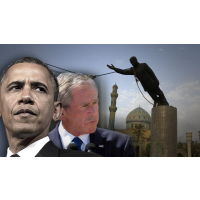If Terrorist Attacks are on the Rise, What Does that Say about the 13-Year-Old “War on Terror”?
 (graphic: CBS, AP)
(graphic: CBS, AP)
The phrase “war on terror” was first used shortly after the September 11, 2001, attacks by then-President George W. Bush. More recently, President Barack Obama declared in 2013 that he’s no longer pursuing the war on terror in favor of “a series of persistent, targeted efforts to dismantle specific networks of violent extremists that threaten America.” But regardless of whether the United States claims to be in such a war, terror attacks continue to increase.
The most recent figures from the State Department show that there was a sharp increase in terror attacks worldwide in 2014 over the numbers from the previous year. According to its figures, attacks increased 35% and fatalities jumped 81% over 2013’s numbers, with the increase coming mainly in Iraq, Afghanistan and Nigeria. Part of the reason for the huge increase in fatalities was the jump in large-scale attacks, those killing more than 100 people. There were 20 such attacks in 2014, compared to two in 2013.
There were a total of 13,463 terrorist attacks last year. The month of May, when fighting in Afghanistan heats up with the weather, had the most with 1,338.
Those aren’t the only metrics available on the war on terror, of course. Another is how much money has been spent. A report (pdf) from the Congressional Research Service (CRS) says that $1.6 trillion has gone into U.S. war efforts since 9/11. That includes “military operations, base support, weapons maintenance, training of Afghan and Iraq security forces, reconstruction, foreign aid, embassy costs, and veterans’ health care for the war operations initiated since the 9/11 attacks,” according to the report. That spending continues to grow. Those numbers don’t include money appropriated since the Consolidated Appropriations Act for fiscal year 2014.
CRS’s dollar figure is stunning on its own. But the Costs of War project, a nonpartisan, nonprofit, scholarly initiative based at Brown University’s Watson Institute for International and Public Affairs, came up with even more eye-popping numbers. They put the cost of the post-9/11 fighting at $4.4 trillion. In addition to the costs of bullets and bandages, they included the interest on the money borrowed to fight the war (remember—Bush sought no tax increases to fund the fighting); the money it took out of the economy and cost Americans in increased interest; the future cost of treating and healing wounded veterans (expected to peak in 30 or 40 years at more than $1 trillion); and increased homeland security spending.
Interest payments on the money borrowed to pay for the war on terror will continue far into the future and are expected to be astronomical as well: $1 trillion by 2023, or more than $7 trillion by 2053.
The Costs of War also looked at what the war on terror cost in terms of lost opportunities; that is, what the money could have been spent on instead of the military, such as domestic infrastructure and non-military job creation.
-Steve Straehley
To Learn More:
Country Reports on Terrorism 2014—Special Briefing (Department of State)
Country Reports on Terrorism 2014—Terrorism Deaths, Injuries and Kidnappings of Private U.S. Citizens Overseas (Department of State)
Country Reports on Terrorism 2014—Annex of Statistical Information (Department of State)
Summary Costs of War, 2001-2014, in Iraq, Afghanistan and Pakistan (Costs of War Project)
The Cost of Iraq, Afghanistan, and Other Global War on Terror Operations Since 9/11 (by Amy Belasco, Congressional Research Service) (pdf)
Obama: ‘Global War on Terror’ Is Over (by Paul D. Shinkman, U.S. News and World Report)
War on Terror Leaves 6,500 Americans with Severe Brain Injury and 1,700 with Amputations (by Matt Bewig, AllGov)
In Wake of U.S. Global War on Terror, International Terrorist Attacks Have Quadrupled since 9/11 (by Noel Brinkerhoff, AllGov)
- Top Stories
- Unusual News
- Where is the Money Going?
- Controversies
- U.S. and the World
- Appointments and Resignations
- Latest News
- Trump to Stop Deportations If…
- Trump Denounces World Series
- What If China Invaded the United States?
- Donald Trump Has a Mental Health Problem and It Has a Name
- Trump Goes on Renaming Frenzy






Comments